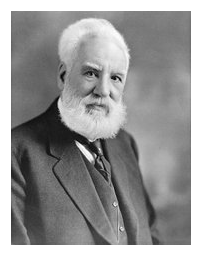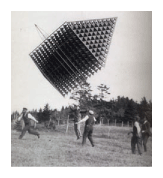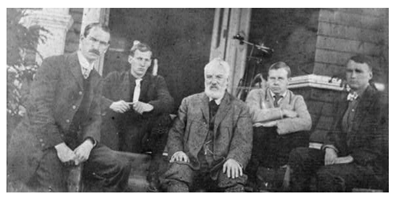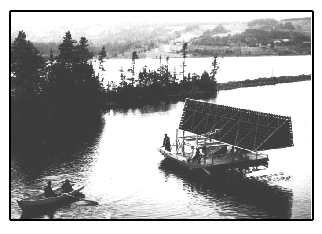Alexander Graham Bell
After the Telephone - Tetrahedral Kites, Airplanes and Hydrofoils
 Alexander Graham Bell is widely known as the inventor of the telephone. His patent for the telephone was issued on March 7, 1876. The patent led to the formation of several companies by Bell. He created a company to manufacture telephones and others to develop and install municipal telephone systems. The patent and subsequent growth of his companies provided him with considerable wealth.
Alexander Graham Bell is widely known as the inventor of the telephone. His patent for the telephone was issued on March 7, 1876. The patent led to the formation of several companies by Bell. He created a company to manufacture telephones and others to develop and install municipal telephone systems. The patent and subsequent growth of his companies provided him with considerable wealth.
Bell was a pioneer in speech and sound research. His work focused on understanding the physical condition of deafness. Bell's work to assist deaf people to learn to speak and utilize sign language is well documented and widely admired.
Bell was truly one of the great scientific and creative minds of the late 19th and early 20th centuries. He utilized his wealth from the invention of the telephone to explore other areas of endeavour. He was instrumental in the formation of the National Geographic Society and its journal, The National Geographic Magazine, one of the most widely recognized journals in the world.
 Bell's pioneering work with the tetrahedral form led to a number of applications. The use of the tetrahedral in the structure of large kites, some of them big enough to carry a person aloft, was remarkable. His experimentation with the tetrahedron was used in construction projects (a tower on his property at Beinn Bhreagh in Cape Breton, N.S. and other structures) as well as in kite framing. Some of the sketches in his notebooks of tetrahedral design ideas show how enamored he was with the utility and strength of the tetrahedron as a three dimensional structure.
Bell's pioneering work with the tetrahedral form led to a number of applications. The use of the tetrahedral in the structure of large kites, some of them big enough to carry a person aloft, was remarkable. His experimentation with the tetrahedron was used in construction projects (a tower on his property at Beinn Bhreagh in Cape Breton, N.S. and other structures) as well as in kite framing. Some of the sketches in his notebooks of tetrahedral design ideas show how enamored he was with the utility and strength of the tetrahedron as a three dimensional structure.
Other efforts in the development of early flight were achieved through his association with a talented group of individuals known as The Aerial Experiment Association. The members of the AEA, in addition to Bell himself, were: Mabel Gardiner Hubbard Bell, Frederick Walker (Casey) Baldwin, John Alexander Douglas McCurdy, Glenn Hammond Curtiss, and Lieutenant Thomas Etholen Selfridge.

AEA at Beinn Bhreagh, Baddeck, N.S. Mabel Bell absent from photo.
The scientific and engineering efforts of the AEA led to the construction and successful flight of four aerodromes (airplanes) powered by engines developed by Glenn Curtiss of Hammondsport, NY. Several devices were constructed by the AEA:
- Cygnet I - a large tetrahedral structured kite-like device (based on Bell's earlier "Frost King" tetrahedral kite of 1905). In the Cygnet, there were 3393 tetrahedral cells each measuring 25 cm along the four dimensions. The cell bank configuration was 52 x 12 x 12. The overall span was 13 m (42.5 feet) and the chord 3 m (9.84 feet). The entire device was fitted with pontoon type floats to support it on water, which was to be the launching surface. The cell structure of this aerodrome was 47.052 kg (104.5 pounds). With floats the device weighed 94.5 kg (208 pounds). Several tests were run by towing the Cygnet behind some boats on Little Bras d'Or Lake in Cape Breton, Nova Scotia. On December 3, 1907 the Cygnet flew briefly as an unmanned kite. Some modest damage happened on landing and the craft was repaired for a December 6, 1907 manned flight trial. Thomas Selfridge was in the flight seat on this occasion. The Cygnet, with Selfridge moving his body around in the space designed for the flier, gained an altitude of 168 feet until the wind dropped and the machine began to descend after seven minutes in the air. The tow boat's line was not cut immediately upon the craft's contact with the water surface and the Cygnet nosed over with Selfridge still in it. The force created by briefly towing the kite in this attitude on the water led to it beginning to submerge and ultimately breaking in two. Selfridge was rescued from the very cold waters and the remainder of the parts of the Cygnet were pulled on to the attending boats. Although the Cygnet was beyond repair, Bell felt that she had "fullfilled her function" and had "demonstrated the important fact that the tetrahedral system can be utilized in structures intended for aerial locomotion." (1)
A graphic timeline, entitled AG Bell - The Aeronautical Exploration Years, outlining the development of the AEA's aerodromes and the lives of the principal members is available for download. Please note, the format of this chart is for study purposes only and permission to republish or distribute must be obtained in writing from the author.
- Glider: Competed January 13, 1908 at Hammondsport, NY.
- Aerodrome No. 1 - The "Red Wing". Thomas Selfridge
- Aerodrome No. 2 - The "White Wing". Casey Baldwin
- Aerodrome No. 3 - The "June Bug". Glenn Curtiss
- Aerodrome No. 4 - The "Silver Dart". Douglas McCurdy
- Aerodrome No. 5 - The "Cygnet II". Alexander Graham Bell. Utilizing the tetrahedral structure used in Cygnet I, Bell had the engine and the propeller from the Silver Dart placed on the Cygnet II. With McCurdy as his chief assistant and pilot, the Cygnet II did not ever reach flight speed in trials on February 24 and March 12, 1908. It was concluded that the Curtiss engine was not powerful enough to lift the craft off the water. Bell ordered the craft to be disabled and returned the engine and propeller to the Silver Dart for further development of that airplane.
- Hydro-Aerodrome No. 6 - The "White Kite". Casey Baldwin and A. G. Bell. This kite crashed and smashed during testing. A second edition, an exact copy, known as "The White Victor" was flown on December 8, 1908 on a 100 m line.
- Work was focused on hydro planes to increase the efficiency of take off of an aerodrome from the water. A special hydrodrome was produced and was christened "Dhonna Beag" (Gaelic for 'Little Devil'). The purpose of the craft was to devise a method of lift from the water by hydro planing the pontoons to aid in eventually lifting off an aircraft. On two occasions on October 8, 1908, carrying two passengers each time, while being towed the "Dhonna Beag" lifted its pontoons out of the water running only on hydro planes . It also achieved a brief lift to 18" on November 18, 1908 under power from her own on board engine. A series of structural mishaps and worsening weather conditions curtailed all further testing in early December 1908. At this point the AEA turned all its attention to further work on the "Silver Dart" and enhancing it's flight abilities.
- After the AEA was disbanded, Bell and Baldwin's work on the hydro plane effect led to the development of the famous HD-4 hydrofoil which set the world record for speed by a water craft in 1918. This water speed record stood until 1929.
Footnote:
- Parkin, J. H. Bell and Baldwin, 48.
___________________________
References:
Journals:
Bell, Alexander G. "The Tetrahedral Principle in Kite Structure". National Geographic Magazine, June 1903. 219-251
Bell, Alexander G. "The Tetrahedral Kite". National Geographic Magazine, July 1903. 294.
Bell, Alexander G. "Aërial Locomotion: With a Few Notes of Progress in the Construction of an Aërodrome". National Geographic Magazine, January 1907. 1-34.
Cameron, Silver Donald. "Bell and Baddeck: His Summer Home Was His Outdoor Laboratory." Canadian Geographic Magazine, Aug./Sept., 1985 - Vol. 105, No,4. 10-19.
Grosvenor, Gilbert Hovey. "Dr. Bell's Man-Lifting Kite". National Geographic Magazine, January 1908. 35-52.
Grosvenor, Gilbert Hovey. " Air Conquest: From the Early Days of Giant Kites and Birdlike Gliders, the National Geographic Society Has Aided and Encouraged the Growth of Aviation". August, 1927. 233-247.
Lesage, Jean and Grosvenor, Gilbert Hovey (Photographer). "Alexander Graham Bell Museum: Tribute to Genius: A Canadian Memorial Reveals New Facts About the Work of an American Scientist". Aug. 1956. 227-256.
Mackenzie, Catherine Dunlop and Grosvenor, Gilbert Hovey (Photographer) . "The Charm of Cape Breton Island: The Most Picturesque Portion of Canada's Maritime Provinces - A Land Rich in Historic Associations, Natural Resources, and Geographic Appeal". July 1920. 34-60.
Books:
Gray, Charlotte. Reluctant Genius. 1st ed. Toronto: HarperCollins Ltd, 2006. 1-407.
[Subtitled: 'The Passionate Life and Inventive Mind of Alexander Graham Bell". This is a thorough and comprehensive life story of Bell with detailed information on his family life as well as his scientific life. Perhaps this is the single best book to read to get the Bell life story and all of his accomplishments. The book is not strong on technical detail, but the chronicle of Bell's life and the portrait of his personality are wonderful. An outstanding book by one of Canada's finest contemporary historians.]
Grosvenor, Edwin, and Morgan Wesson. Alexander Graham Bell. New York: Harry Abrams, 1997.
[Bell's complete life story with outstanding photographs of all of Bell's work including his work with kites, aerodromes and hydrodromes.]
Matthews, Tom L. Always Inventing: A Photobiography of Alexander Graham Bell. Washington, D.C.: National Geographic Society, 1999. 1-164.
[A photographic journey through A.G. Bell's life and accomplishments. Some of the photos from the National Geographic Society's archives used in this book are rarely seen in other publications.]
Newhouse, Elizabeth L. (Ed.). Inventors and Discoverers: Changing our World. Washington, D.C.: National Geographic Magazine, 1988.
[This book contains an excellent chapter on Alexander Graham Bell - Pages 68-73.]
Parkin, J. H. Bell and Baldwin: Their Development of Aerodromes and Hydrodromes at Baddeck, Nova Scotia. Toronto: University of Toronto Press, 1964. 1-555.
[Includes excellent tables, photographs and data on flight testing of the kites and aerodromes of the Aerial Experiment Association. This is the most comprehensive technical outline of Bell's work on kites, flight and hydrofoils.]
Roseberry, C. R. Glenn Curtiss: Pioneer of Flight. New York: Doubleday & Company, 1972. 1-514.
[A detailed biography of Glenn Curtiss. This book details Curtiss' life before and after his involvement with Alexander Graham Bell and the Aerial Experiment Association. Terrific photos and lots of technical details as well as insights into Curtiss' family background and character. Solid interface with Bell's early work on flight and aircraft, especially noting the contributions of Curtiss in the process. Good information on the Curtiss engines used to power Bell's aerodromes. An excellent historical resource and a good read.]
World Wide Web:
- Wikipedia: Alexander Graham Bell
- Alexander Graham Bell - Biography
- Alexander Graham Bell - Family Papers (Library of Congress)
- Alexander Graham Bell - One of Canada's Greatest Canadians
- Alexander Graham Bell National Historic Site of Canada (Parks Canada: A.G. Bell Museum, Baddeck, N.S.)
- Alexander Graham Bell Homestead - Brantford, Ontario, Canada
- Flights of Fancy by Margaret Robinson - reprint of original article in Kiting: the Journal of the American Kitefliers Association Fall 2001-Vol. 23, Issue 4.





